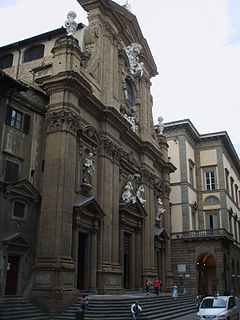The School of Ferrara was a group of painters which flourished in the Duchy of Ferrara during the Renaissance. Ferrara was ruled by the Este family, well known for its patronage of the arts. Patronage was extended with the ascent of Ercole d'Este I in 1470, and the family continued in power till Alfonso II, Ercole's great-grandson, died without an heir in 1597. The duchy was then occupied in succession by Papal and Austrian forces. The school evolved styles of painting that appeared to blend influences from Mantua, Venice, Lombardy, Bologna, and Florence.

Santa Maria Maddalena dei Pazzi is a Renaissance-style Roman Catholic church and a former convent located in Borgo Pinti in central Florence.

Giuseppe Zocchi was an Italian painter and printmaker active in Florence and best known for his vedute of the city.

The Lives of the Most Excellent Painters, Sculptors, and Architects, often simply known as The Lives, is a series of artist biographies written by 16th-century Italian painter and architect Giorgio Vasari, which is considered "perhaps the most famous, and even today the most-read work of the older literature of art", "some of the Italian Renaissance's most influential writing on art", and "the first important book on art history".

San Gaetano, also known as Santi Michele e Gaetano, is a Baroque church in Florence, Italy, located on the Piazza Antinori, entrusted to the Institute of Christ the King Sovereign Priest.
Nannina de' Medici, born Lucrezia de' Medici, was the second daughter of Piero di Cosimo de' Medici and Lucrezia Tornabuoni. She was thus the elder sister of Lorenzo de' Medici. She married Bernardo Rucellai. Her father's name was Piero, so she is sometimes known as Lucrezia di Piero de' Medici.

The Biblioteca Riccardiana is a library in Florence, Italy. The library is located adjacent to the Palazzo Medici Riccardi. The main facade of Michelozzo's Medici Riccardi palace is on Via Camillo Cavour, while Riccardiana library's main but unimposing entrance and facade is located on Via de' Ginori, parallel and northeast of Cavour. The rear of the Medici palace has a small polygonal private garden, whose north side also has an entrance to the library.

Bernardo Rucellai, also known as Bernardo di Giovanni Rucellai or as Latin: 'Bernardus Oricellarius', was a member of the Florentine political and social elite. He was the son of Giovanni di Paolo Rucellai (1403–1481) and father of Giovanni di Bernardo Rucellai (1475–1525). He was married to Nannina de' Medici, the elder sister of Lorenzo de' Medici, and was thus uncle to Popes Leo X and Clement VII, who were cousins. Oligarch, banker, ambassador and man of letters, he is today remembered principally for the meetings of the members of the Accademia platonica in the Orti Oricellari, the gardens of his house in Florence, the Palazzo Rucellai, where Niccolò Machiavelli gave readings of his Discorsi.

Giovanni di Paolo Rucellai (1403–1481) was a member of a wealthy family of wool merchants in Renaissance Florence, in Tuscany, Italy. He held political posts under Cosimo and Lorenzo de' Medici, but is principally remembered for building Palazzo Rucellai, for his patronage of the S. Sepolcro chapel and of the marble façade of the church of Santa Maria Novella, and as author of the Zibaldone. He was the father of Bernardo Rucellai (1448–1514) and grandfather of Giovanni di Bernardo Rucellai (1475–1525).

The two fontane dei mostri marini are located in the Santissima Annunziata plaza in Florence.

An anonymous author known as the Anonimo Gaddiano, Anonimo Magliabechiano, or Anonimo Fiorentino is the author of the Codice Magliabechiano or Magliabechiano, a manuscript with 128 pages of text, probably from the 1530s and 1540s, and now in the Central National Library of Florence. It includes brief biographies and notes on the works of Italian artists, mainly those active in Florence during the Middle Ages. Among several other suggestions, the anonymous author has been suggested to be Bernardo Vecchietti (1514–1590), a politician of the court of Cosimo I. The author clearly had intimate access to the Medici court.
The Loggiato is the semi-enclosed courtyard space between the two long galleries of the Uffizi Gallery located adjacent to the Piazza della Signoria in the historic center of Florence, capital of Tuscany, Italy. Because the facade of the arcaded corridor parallel to the Arno River also continues the sculptural display of the cortile, it can also be included in the description.
Giovanni Battista Cecchi was an Italian engraver, active in a neoclassical style in his native Florence, Region of Tuscany, Italy.









